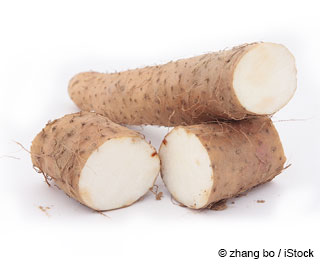Yam Fest
Botanical name: Dioscorea rotundata

While yams appear very similar to sweet potatoes, they're quite different. In fact, they're not even related. Yams belong to the Dioscoreae family, while sweet potatoes are from the genus Convolvulaceae, or the morning glory family.1 Yams (from the African word "nyami," meaning "to eat")2 have only one embryonic seed leaf, while sweet potatoes have two.3
Yams are grown throughout the world, with West Africa as its top producer. As of 2019, Nigeria is the world's most prolific producer, making over 60% of the world market.4 Over 200 species of yams5 are cultivated and eaten worldwide, but other than those found wrapped individually in supermarkets, they aren't easily found on American produce shelves.
Compared to sweet potatoes, yams are usually longer — sometimes as long as several feet — and not as sweet, having a rough, blackish or brown surface that looks like tree bark, and flesh that's either reddish, white or purple.6
They're usually harvested after six months to a year of vine growth,7 and dried for several hours (a process called "curing"),8 after which they can be stored without refrigeration. In fact, yams should never be refrigerated until they're cooked, as this will give them a hard interior and an unappealing flavor. Ideally, store yams in a dark, cool place for up to a month.9
Yam varieties are classified as either "firm" or "soft." When cooked, the firm yams stay dense, while soft varieties turn tender and moist.10 Culinary preparations can be as vast the varieties, including boiling, mashing, grilling, roasting, baking or sautéing. After cooking yams, wrap and refrigerate the leftovers, making sure to eat them within a few days.
Health Benefits of Yam
Yams are a good source of fiber, protein, starch, lipid and vitamins and minerals,11 nutrients that play a role in its antimicrobial, hypoglycemic and antioxidant activities.12 A particular compound, called saponins, may help curb inflammation and return the balance of your gut flora. Examples of saponins in yams include dioscin, diosgenin and dioscorin. Dioscorin in particular is said to "exhibit antioxidant, antihypertensive, immunomodulatory, lectin activities and can protect airway epithelial cells against dust mite allergen destruction."13
The vitamin A in yams14 may help maintain healthy mucous membranes15 and skin, as well as heightening night vision,16 supporting healthy bone development17 and providing protection from lung18 cancer.
Yams are a good source of vitamin C — with 17.1 milligrams per 100-gram serving.19 It's an essential nutrient for fighting infections such as colds and flu20 and helps in quick wound healing,21 anti-aging,22 strong bones23 and healthy immune function.24 Yams also provide good amounts of fiber, potassium, manganese and metabolic B vitamins.25 The content of vitamin B6 (0.293 milligrams per 100-gram serving), or pyridoxine, is good for shrinking the effects of homocysteine, which can do real damage to cell walls that could lead to heart attacks and/or stroke.26,27
Other nutrients in yams include thiamin (vitamin B1), riboflavin, folic acid, and niacin.28 pantothenic acid Copper (which produces healthy red blood cells29), calcium, potassium (supporting optimal cell and body fluids30), iron, manganese (a component in the super-potent antioxidant enzyme superoxide dismutase31,32) and phosphorus are body-beneficial minerals found in yams.33
For more about the health benefits of yams, read this article. You can also check out the nutrition facts below.34
Yam Nutrition Facts
Serving Size: 3.5 ounces (100 grams), raw
| Calories |
118 |
|
| Total Fat |
0.17 g |
|
| Saturated Fat |
0.037 g |
|
| Cholesterol |
0 mg |
|
| Sodium |
9 mg |
|
| Total Carbohydrates |
27.88 g |
|
| Dietary Fiber |
4.1 g |
|
| Sugar |
0 g |
|
| Protein |
2 g |
|
| Calcium 17 mg |
Iron |
0.54 mg |
Studies on Yam
There's an interesting link between yams and unpleasant menopausal symptoms. Wild yam extracts have been studied as a possible remedy, due to their steroidal saponin compounds, but there has been nothing conclusive so far. Among the saponin compounds is diosgenin, which tests have shown to exert a positive impact on hormonal patterns, and possible benefits for lowering the risk of osteoporosis.35
A separate study found that one yam variety, Dioscorea bulbifera, helped improve ventricular function and protect the tissues surrounding the heart.36
Yam Healthy Recipes:
Yam 'Chips' With Cinnamon and Nutmeg

|
Ingredients:
|
|
✓ 2 large yams, peeled and sliced ¼-inch thick
|
✓ Coconut oil, to drizzle
|
✓ 1 tablespoon ground cinnamon
|
|
✓ 1 teaspoon grated nutmeg
|
✓ Honey, to drizzle
|
|
Procedures:
- Preheat oven to 450 degrees Fahrenheit.
- Place sliced yams in a rectangular glass dish. Drizzle lightly with coconut oil. Sprinkle with cinnamon and nutmeg. Drizzle with honey. Place in oven for 20 minutes.
- Allow to cool slightly before serving.
This recipe makes four servings.
(From "Healthy Recipes for Your Nutritional Type" by Dr. Mercola)
Yam Fun Facts
Yams should never be eaten raw, as they contain poisonous toxins. However, cooking them (boiling or roasting is recommend) and then peeling off their skin will make them safe to eat. You can also use yams as a substitute for sweet potato in recipes.37,38
Summary
Thought to be one of the world's earliest cultivated vegetables, yams may be undergoing an identity crisis due to their frequent comparison to sweet potatoes. Though yams don't come close to the vitamin A content and carotenoid presence in sweet potatoes, this world-traveling tuber has a unique set of phytonutrients. Besides strong antioxidants, including the enzyme superoxide dismutase, yams contain vitamin C, fiber, potassium, manganese, B vitamins, and a long line of other minerals like riboflavin, potassium, iron and manganese.
Yams shouldn't be refrigerated unless they've already been cooked. Recipes can swing to the sweet or savory side, depending on your desire. But either way, they generally command a second helping.